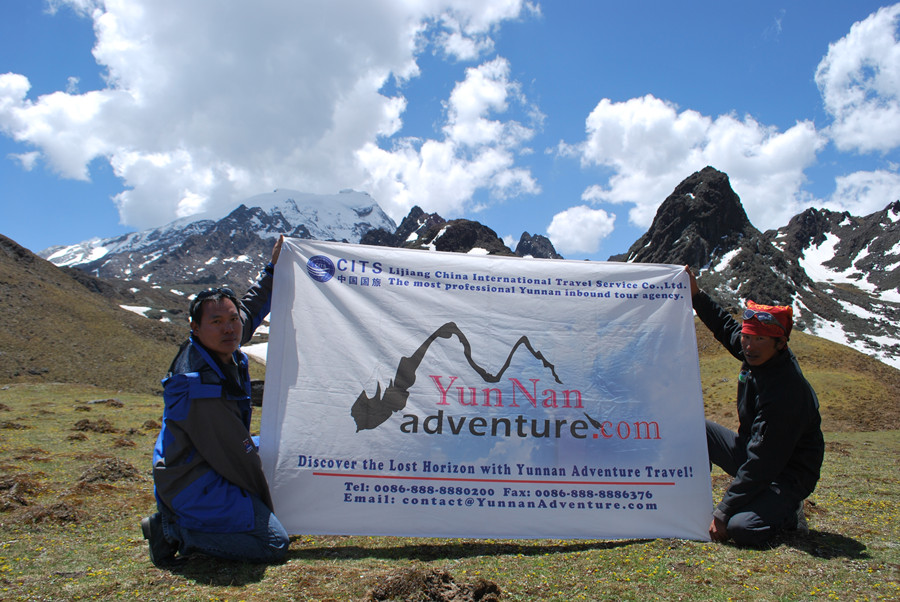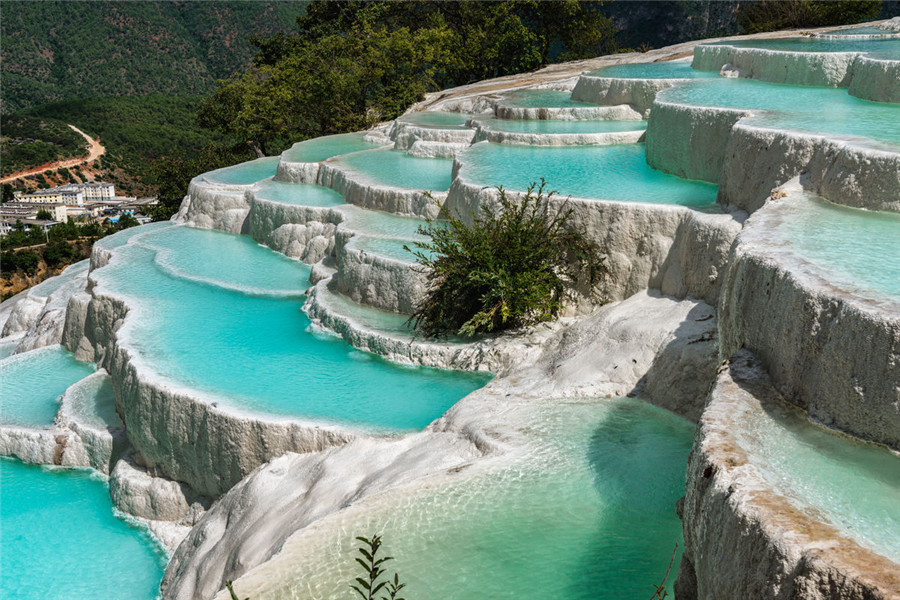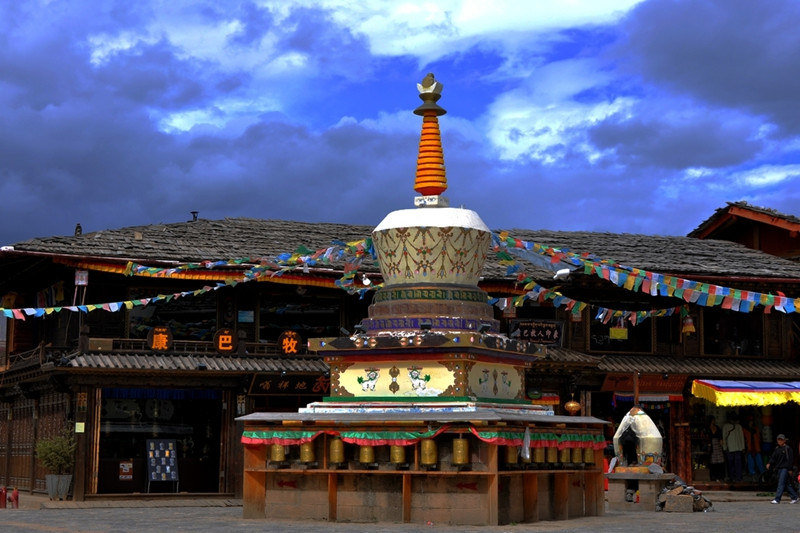
Shangri-La Overview
Shangri-la overview can help you have a more comprehensive understanding of Shangri-la from the basic information, geographical location, climate and so on.
Basic Information
- Chinese Name: 香格里拉
- Location: Northwest of Yunnan Province
- Administrative Category: County-level City
- Seat of Government: Jiantang Town(建塘镇)
- Area: 11,613 square kilometers
- Population: An approximate population of 174,585
- Ethnic Groups: Han, Tibetan, Naxi, Yi, Bai, Zhuang, Miao, Hui, Lisu, Lahu, Wa, Yao, Jingpo, Bulang, etc.
- Main Airport: Diqing Shangri-la Airport
- Important Festival and Activitie: Tibetan New Year, Er Yue Ba, Horse Racing Festival, Dengba Festival, Gedong Festival.
- Railway Stations: Shangri-la Railway Station
- Famous Attractions: Tiger Leaping Gorge, Songzanlin Monastery, Haba Snow Mountain, Pudacuo National Park, Baishuitai, Napahai Lake and Meili Snow Mountain, etc.
Geography
Shangri-la is located in the great triangle area of Yunnan, Sichuan and Tibet, in the northwest of Yunnan province. It borders Daocheng and Muli county in the east, faces Lijiang city and Weixi county across the Jinsha river, and connects Deqin county in the north. The city covers an area of 11,613 square kilometers.
The terrain in the territory is generally high in the northwest and low in the southeast. The highest point is Balagzon(巴拉格宗) with an altitude of 5545 meters, the lowest point is Luojijihan(洛吉吉函) with an altitude of 1503 meters, with an altitude difference of 4042 meters and an average altitude of 3459 meters. Shangri-la is located on the southeast edge of the Qinghai-Tibet plateau, at the northern end of the southern section of the Hengduan mountains, and in the hinterland of "three parallel rivers", forming a unique landscape integrating snow mountains, valleys, grasslands, alpine lakes, virgin forests and ethnic customs.
Climate
Shangri-la is more than 3300 meters above sea level, and belongs to plateau humid climate. The climate changes little among the four seasons, but the temperature varies greatly between day and night. The temperature can be more than 30℃ on sunny days. However, in the morning and evening, people may feel as cold as winter. So, visitors should take their coats with them when visiting Shangri-la.
Best Time to Visit
May to October is the best time to Shangri-la, at that time, the galsang flowers are blooming and the meadow is evergreen, full of artistic conception.
Administrative Divisions
As of 2014, Shangri-la has jurisdiction over 4 towns and 7 townships (including 1 ethnic township), with a total of 6 communities and 58 administrative villages. The municipal government is stationed in Jiantang town.
- 4 Towns: Jiantang Town(建塘镇), Xiaozhongdian Town(小中甸镇), Hutiaoxia Town(虎跳峡镇), Jinjiang Town(金江镇)
- 6 Townships: Shangjiang Township(上江乡), Luoji Township(洛吉乡), Nixi Township(尼西乡), Geza Township(格咱乡), Dongwang Township(东旺乡), Wujing Township(五境乡).
- 1 Ethnic Town: Sanba Naxi Ethnic Town(三坝纳西族乡)
Shangri-la Culture
Shangri-la is inhabited by many different ethnic groups, with Tibetans accounting for the majority of the population and possessing a strong Tibetan cultural atmosphere. Each ethnic minority there has its own unique customs, traditions and architectural styles, making shangri-la a picturesque village. You will have the chance to experience Tibetan life, learn about their lifestyle, religion and cuisine. If time permits, come and join the Dengba festival and Gedong festivel of Tibetan in Shangri-la, know the Tibetan culture further.
- Culture of Niru Village in Shangri-La
- Haba Snow Mountain Culture in Shangri-La
- Baishuitai Culture in Shangri-La
- Shangrila City Culture
Shangri-la Food
The population of Shangri-la consists mainly of Tibetans together with many ethnic minorities. This creates a chance to immerse yourself in the beautiful scenery while enjoying the local food and drinks. When visiting Shangri-la during your Yunnan travel, Tibetan cakes, zanba, pipa meat, buttered tea, yogurt and barley wine(a Tibetan wine made from barley) are must taste. Zanba is the Tibetan staple food, made of highland barley powder. Usually, the local people like to drink butter tea while eating zanba. Yak butter tea is rich in energy and provides nutrients in the cold highland climate. Pipa pork is a non-greasy marinated pork that is often used to entertain guests.
Transportation
Shangri-la is located in the northwest of Yunnan province, with an average altitude of more than 3,000 meters. The special geographical location makes Shangri-la transportation different from other parts of China. It currently has only one airport with relatively limited daily flights. So far, there is no railway to Shangri-la(Lijiang-Shangrila railway is under construction). Therefore, the traffic to Shangri-la city is mainly by road, and there are highways network of Yunnan-Tibet highway and Sichuan-Tibet highway.
Things to Do
There are a lot of things to do in Shangri-la, like visiting Songzanlin monastery, cycling around Napa lake and Yubeng hiking. Here below are several of them.
Tibetan Family Visiting
Tibetan people are one of the most important Chinese minorities with unique traditions and customs, who are most concentrated on the western borders of China. They are very open to the world. Tibetan home visiting in Shangri-La is a good way to learn about the culture and way of life of today's Tibetan families. It's an interactive activity of experiencing the original, unique and colorful Tibetan customs. You can taste authentic Tibetan food like butter tea and zanba, and learn Tibetan culture in a more direct way.
Tiger Leaping Gorge Hiking
When it comes to Shangri-la hiking tour, there must be Tiger Leaping Gorge. Tiger Leaping Gorge is spectacular and crown as one of the deepest gorge in the world. Foreign backpackers started hiking in the area in the 1980s and now Tiger Leaping Gorge Hiking Tour has been one of the most famous hiking tour all around the world.
Haba Snow Mountain Climbing
Haba Snow Mountain is the best mountain for climbing tours in Yunnan with an elevation of 5396 meters in the summit. It allows you to experience the typical process of climbing a snow mountain. It is not a hard climbing route. The most difficult is to overcome the altitude sickness. For 5 days Haba Snow Mountain climbing tour, you will have one more day for adapting high altitude from Base Camp to Base Camp 1.
Meili Snow Mountain Pilgrimage
Located 10 kilometers northeast of Deqin County of Yunnan Province, sitting on the border of Yunnan Province and Tibet, Meili Snow Mountain is one of the most sacred mountains of Tibetan Buddhism. It has always been the holy mountain in Tibetan people's hearts and minds, every year, countless people travelling a far distance come to worship. When you see the snow mountain, you will be shocked by its numerous snow-clad ridges and peaks.
- Lists of Professional Mountain Guide in Haba Snow Mountain, Shangri-La
- Top 10 Diqing Shangri-la Tourist Attractions Rated on TripAdvisor
Story about Shangri-La
In China, the poet Tao Yuanming of the Jin Dynasty described a kind of Shangri-La in his work the Tale of the Peach Blossom Spring. The story goes that there was a fisherman from Wuling, who came across a beautiful peach grove, and he discovered happy and contented people who lived in complete isolation from the outside world since the Qin Dynasty. In modern China, Zhongdian county was renamed Shangri-La City in 2001, to attract tourists.
A popularly believed physical inspiration for Hilton's Shangri-La is the Hunza Valley in northern Pakistan, close to the Chinese border, which Hilton visited a few years before Lost Horizon was published. Being an isolated green valley surrounded by mountains, enclosed on the western end of the Himalayas, it closely matches the physical description in the novel. The Hunza Valley, however, lacks Tibetan culture and the Buddhist religion, so could not have been Hilton's cultural inspiration for Lost Horizon.
- History of Niru Village in Shangri-La
- Haba Snow Mountain Climbing History
- Baishuitai History in Shangri-La
- History of Shangri-La City and The Name of Shangri-La
Economy
In 2016, the total GDP of Shangri-la reached 1.109519 billion yuan, an increase of 10.5% over the previous year. The added value of the primary industry reached 426.57 million yuan, up 5.1%; The added value of the secondary industry reached 3917.54 million yuan, up 15.5%; The added value of the tertiary industry reached 6751.08 million yuan, up 8%. The proportion of the primary, secondary and tertiary industries in GDP was adjusted from 4.1:34.5:61.4 in the previous year to 3.84:35.31:60.85. The proportion of the primary industry was 0.26% points lower than that of the previous year, the proportion of the secondary industry was 0.81% points higher than that of the previous year, and the proportion of the tertiary industry was 0.55% points lower than that of the previous year. On April 30, 2019, the people's government of Yunnan province decided to remove Shangri-la from the list of poverty-stricken counties.
Natural Resources
Shangri-la is known as the "alpine garden", "kingdom of plants and animals" and "kingdom of non-ferrous metals".
Water Resources
Within the territory, rivers belong to the Jinsha river water system, in addition to the main stream of Jinsha river, there are 144 rivers of large and small, of which, for many years, rivers with the average flow rate in 3.7- 43.7 cubic meters per second include Shuoduogang river(硕多岗), Gangqu river(冈曲), Dongwang river(东旺河), Niru river(尼汝河), Jiren river(吉仁河), Langdu river(浪都河), Annan river(安南河), Liangmei river(良美河), Tangman river(汤满河), Anle river(安乐河), Baishui river(白水河), Maidi river(麦地河), etc. These rivers feed into the Jinsha river at different reaches. Besides, Shangri-la has 298 alpine lakes (including moraine lakes), among which the largest and most beautiful are Napa Lake, Bita Lake, Shudu Lake and Sanbi Lake.
Mineral Resources
As of 2010, Shangri-La has had 25 known mineral resources, including gold, silver, copper, iron, tungsten, beryllium, Mo, Mn, lead, zinc, talc, asbestos, dolomite, marble, lignite, peat and so on. There were 120 ore deposits and mineral occurrences. Among them, 1 large mineral deposit, 5 medium mineral deposits and 15 small mineral deposits were known at that time.
Biological Resources
Up to 2010, there are 92 species of 24 families of edible and medicinal fungi in Shangri-la, 3582 species of 234 families of vascular plants, including 36 families and 144 species of bryophytes, 25 families and 160 species of ferns, and 173 families and 3278 species of seed plants. Endangered plants are moccasin flower(杓兰), Zhongdian horned fern(中甸角蕨), Zhongdian dahurian rose fruit(中甸刺玫). Endangered animals include Yunnan snub-nosed monkey, Pudacuo Hangyodon(普达措半鱼人), black-necked crane, mountian carps(裂腹鱼) and so on.

 7 Days GolfingTour
7 Days GolfingTour
 8 Days Group Tour
8 Days Group Tour
 8 Days Yunnan Tour
8 Days Yunnan Tour
 7 Days Shangri La Hiking
7 Days Shangri La Hiking
 11 Days Yunnan Tour
11 Days Yunnan Tour
 6 Days Yuanyang Terraces
6 Days Yuanyang Terraces
 11 Days Yunnan Tour
11 Days Yunnan Tour
 8 Days South Yunnan
8 Days South Yunnan
 7 Days Tea Tour
7 Days Tea Tour
 8 Days Muslim Tour
8 Days Muslim Tour
 12 Days Self-Driving
12 Days Self-Driving
 4 Days Haba Climbing
4 Days Haba Climbing
 Tiger Leaping Gorge
Tiger Leaping Gorge
 Stone Forest
Stone Forest
 Yunnan-Tibet
Yunnan-Tibet
 Hani Rice Terraces
Hani Rice Terraces
 Kunming
Kunming
 Lijiang
Lijiang
 Shangri-la
Shangri-la
 Dali
Dali
 XishuangBanna
XishuangBanna
 Honghe
Honghe
 Kunming
Kunming
 Lijiang
Lijiang
 Shangri-la
Shangri-la
 Yuanyang Rice Terraces
Yuanyang Rice Terraces
 Nujiang
Nujiang
 XishuangBanna
XishuangBanna
 Spring City Golf
Spring City Golf
 Snow Mountain Golf
Snow Mountain Golf
 Stone Mountain Golf
Stone Mountain Golf













